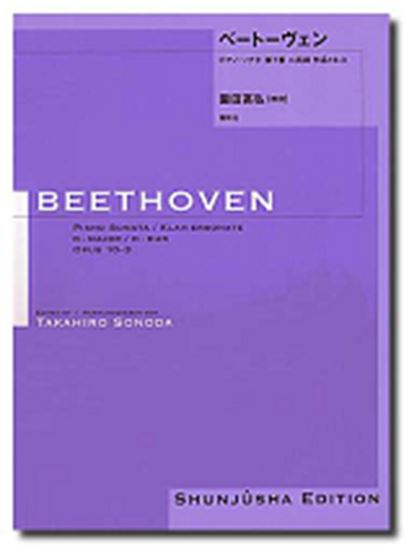Beethoven, Ludwig van : Sonate für Klavier Nr.7 D-Dur Op.10-3
Work Overview
Publication Year:1798
First Publisher:Eder
Instrumentation:Piano Solo
Genre:sonata
Total Playing Time:23 min 30 sec
Copyright:Public Domain
Commentary (2)
Author : Kikuchi, Yusuke
Last Updated: April 1, 2020
[Open]
Author : Kikuchi, Yusuke
First Movement
This sonata is associated with the legend that Beethoven himself stated it depicted "a certain mentally ill person." The opening is played p (the opening of all movements in this sonata is p). The opening first theme consists of two elements: motive a, formed by a four-note stepwise descent (D-C#-B-A), and motive b, formed by a three-note ascending inversion (C#-D-F#). These two short motives are developed with unparalleled thoroughness throughout all four movements of this sonata. Even in the first movement, the majority of the movement, including the second theme and the short coda, is derived from the former motive a. In the first movement, this is placed anacrustically, creating a rhythmic pulse. Highlights include the whole notes played Tutti-like and ff in various places.
Second Movement
Among Beethoven's early works, this movement possesses outstanding musicality for its depiction of the darkest abysses of the human psyche. Here too, both motive a and motive b appear, but whereas the first movement primarily developed motive a, in this second movement, motive b makes an extremely strong impression from the very beginning. The perfect fourth interval inherent in the three notes of motive b is greatly transformed here (perfect fourth → diminished fourth), and this interval, resisting ascent, suggests a strong psychological sense of confinement. Numerous dissonances, especially diminished seventh chords, are repeatedly played ff, creating the effect of a panic-stricken, escalating cry of the heart. The long coda ascends spirally with hesitation, pleading for help from heaven, but it does not reach revelation. Instead, it sinks back into the abyss with the deep despair conveyed by numerous diminished intervals (diminished fourth, diminished seventh, diminished third).
Third Movement
The revelation that was ultimately not attained in the second movement is brought about at the beginning of this third movement by a liberating ascent of a major sixth following a brief suspension from an anacrusis, and the subsequent motive a. Marked dolce, it is one of the most beautiful transitions of "scene" between the movements of the sonata. Although marked "Menuetto," it is played at a somewhat faster tempo, similar to many of Beethoven's minuet movements, and possesses a character intermediate between a minuet and a scherzo. The Trio is unreservedly bright. As for the motives, it uses the bridging section between a and b, and can be said to depict a very German character: dancing cheerfully for a moment, even while harboring darkness in the heart.
Fourth Movement
In the first movement, motives were presented in the order a → b, but here motive b again comes to the forefront, presented in the order b → a. Motive b here regains its sanity (diminished fourth → perfect fourth), but it still seems unsatisfied, repeatedly posing questions without receiving answers. The nightmare of diminished seventh chords still appears in various places. In this movement, all elements seen throughout the sonata recur, leading to a certain catharsis. However, the piece concludes with suggestions that the "certain mentally ill person" consistently depicted in this sonata did not overcome their illness, but rather accepted coexistence with it.
Author : Saitoh, Noriko
Last Updated: May 1, 2007
[Open]
Author : Saitoh, Noriko
It is the last of the three sonatas (Opus 10) dedicated to Countess Anna Margarete von Browne.
First Movement
The first movement is a Presto in D major, 2/2 time, in sonata form. Between the first theme in D major and the second theme in A major, a distinct middle theme in B minor is introduced. This middle theme reappears in E minor in the recapitulation. Furthermore, a sonata with a Presto first movement is only found elsewhere in Sonata No. 25 in G major, Op. 79.
Second Movement
The second movement is a Largo e mesto in D minor, 6/8 time, in an irregular sonata form where an entirely new theme appears in the development section. Additionally, both the first and second themes are recapitulated in a condensed form.
Third Movement
The third movement is a Minuet, Allegro, in D major, 3/4 time, in ternary form. The elegant minuet of the main section contrasts with the trio, which features a distinctive leaping figuration in the left hand.
Finale
The finale is a Rondo, Allegro, in D major, 4/4 time, in rondo form with two subordinate themes. It is interesting that the first subordinate theme, while in the same key of D major as the main theme, creates a different atmosphere. This subordinate theme feels connected to the first theme of the first movement.
Thus, while it appears to have a traditional sonata structure—sonata form, slow movement, minuet, and rondo—it is evident that Beethoven undertook various experiments within this framework. Furthermore, throughout the sonata, the frequent use of diminished seventh chords and chromaticism, particularly noticeable in the second movement, creates an atmosphere of profound sorrow compared to the other movements.
Movements (4)
3.Satz Menuetto e Trio-Allegro
Total Performance Time: 3 min 00 sec
PTNA & Partner Channel Videos(17items) View More
- favorite_border
- 0
Recording Date: 2025/8/21
Recording Location: 第一生命ホール(2025年ピティナ・ピアノコンペティションPre特級)
- favorite_border
- 1
Recording Date: 2024/8/18
Recording Location: 第一生命ホール(2024年ピティナ・ピアノコンペティション 特級 セミファイナル)
- favorite_border
- 0
Recording Date: 2024/8/18
Recording Location: 第一生命ホール(2024年ピティナ・ピアノコンペティション 特級 セミファイナル)
- favorite_border
- 0
Recording Date: 2024/8/18
Recording Location: 第一生命ホール(2024年ピティナ・ピアノコンペティション 特級 セミファイナル)
- favorite_border
- 0
Recording Date: 2024/8/18
Recording Location: 第一生命ホール(2024年ピティナ・ピアノコンペティション 特級 セミファイナル)
Sheet Music
Scores List (12)

(株)春秋社

(株)全音楽譜出版社

(株)全音楽譜出版社

(株)全音楽譜出版社

ヘンレ社(ヤマハ)

(株)音楽之友社

Barenreiter













![ベートーヴェン・ピアノ作品集1 ソナタ集[歴史的注解付批判校訂版] - 楽譜表紙画像](https://ptna-assets.s3.ap-northeast-1.amazonaws.com/enc/books/391.jpg)



